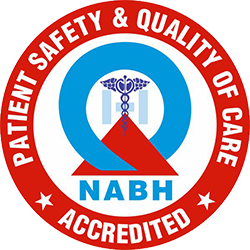National Accreditation Board for Hospitals & Healthcare Providers (NABH)
National Accreditation Board for Hospitals & Healthcare Providers (NABH)
Description also available in video
format (attached below), for better experience use your desktop
Introduction
· NABH
stands for the National Accreditation Board for Hospitals & Healthcare
Providers.
· It is
a constituent board of Quality Council of India, set up to establish and
operate accreditation program for healthcare organizations.
· NABH
accreditation is a quality assurance mechanism that indicates the adherence to
set standards and protocols in healthcare delivery.
Objective of
NABH
The
objectives of NABH accreditation include:
- Quality Improvement:
Encouraging healthcare organizations to adopt best practices and
continually improve the quality of care and services provided to patients.
- Standardization:
Setting and maintaining standards for healthcare delivery, infrastructure,
and management systems to ensure uniformity and consistency across
accredited facilities.
- Patient Safety:
Ensuring patient safety is a top priority by implementing robust systems
and processes to minimize risks, errors, and adverse events in healthcare
delivery.
- Enhancing Patient Satisfaction:
Focusing on patient-centered care and satisfaction by promoting practices
that prioritize patient needs, preferences, and feedback.
- Capacity Building:
Facilitating capacity building and skill enhancement among healthcare
professionals and staff through training programs and workshops on quality
improvement methodologies.
- Public Confidence:
Building trust and confidence among patients, caregivers, and stakeholders
by demonstrating compliance with internationally recognized standards and
best practices.
- Market Differentiation:
Providing a competitive edge to accredited healthcare organizations by
distinguishing them in the market as providers of high-quality care and
services.
- Regulatory Compliance:
Helping healthcare facilities align with regulatory requirements and
standards set by government agencies and regulatory bodies.
- Continuous Monitoring and Evaluation:
Conducting regular assessments and evaluations to ensure ongoing
compliance with accreditation standards and identify areas for
improvement.
- International Recognition:
Facilitating international recognition and acceptance of Indian healthcare
organizations by aligning accreditation standards with global benchmarks
and requirements.
Standards of
NABH
NABH
standards are categorized into different chapters, each focusing on specific
aspects of healthcare delivery. Here are the chapters and standards of NABH:
- Access, Assessment, and Continuity of
Care (AAC): This chapter focuses on ensuring
that healthcare services are accessible, assessment processes are
comprehensive, and there is continuity of care for patients.
- Care of Patients (COP):
This chapter outlines standards related to patient care, including
clinical management, medication management, infection control, and patient
rights.
- Management of Medication (MOM):
Standards in this chapter emphasize the safe and effective management of
medications, including prescribing, dispensing, administration, and
monitoring.
- Patient Rights and Education (PRE):
Standards in this chapter address patient rights, informed consent,
confidentiality, and patient education.
- Hospital Infection Control (HIC):
This chapter focuses on preventing and controlling healthcare-associated
infections within healthcare facilities.
- Continual Quality Improvement (CQI):
Standards in this chapter focus on establishing mechanisms for continual
quality improvement in healthcare services, including monitoring,
evaluation, and feedback processes.
- Responsibilities of Management (ROM):
This chapter outlines the responsibilities of healthcare facility
management in ensuring quality and patient safety, including governance,
leadership, and resource management.
- Facility Management and Safety (FMS):
Standards in this chapter address facility management, safety protocols,
disaster preparedness, and environmental safety.
- Human Resource Management (HRM):
This chapter focuses on human resource management practices, including
staff qualifications, training, and competency assessment.
- Information Management System (IMS):
Standards in this chapter focus on establishing effective information
management systems for patient records, data security, and information
exchange.
Accreditation
Process of NABH
The
accreditation process of NABH typically involves several steps:
- Pre-Assessment:
The healthcare organization interested in accreditation conducts a
self-assessment to evaluate its readiness and compliance with NABH
standards. This step helps identify areas that need improvement before the
formal assessment.
- Application Submission:
The healthcare organization submits an application for accreditation to
NABH along with the required documents and fees.
- Document Review:
NABH reviews the submitted documents, including policies, procedures,
records, and other relevant materials, to ensure compliance with the
accreditation standards.
- Assessment Team Selection:
NABH selects a team of assessors, comprising healthcare professionals with
expertise in various domains, to conduct the on-site assessment.
- On-Site Assessment:
The assessment team visits the healthcare organization to conduct an
on-site assessment. During this phase, they review processes, observe
practices, interview staff, and assess compliance with NABH standards.
- Assessment Report:
Based on the findings of the on-site assessment, the assessment team
prepares a detailed report highlighting areas of compliance and
non-compliance with NABH standards.
- Decision Making:
NABH reviews the assessment report and decides whether to grant
accreditation based on the organization's compliance with the standards.
If deficiencies are identified, the organization may be given an
opportunity to address them through corrective actions.
- Accreditation:
If the healthcare organization meets the accreditation criteria, NABH
grants accreditation for a specified period, typically three years. The
organization receives a certificate recognizing its achievement.
- Surveillance Visits:
During the accreditation period, NABH may conduct surveillance visits to
ensure that the organization maintains compliance with the standards.
These visits help in monitoring ongoing quality improvement efforts.
- Renewal:
At the end of the accreditation period, the healthcare organization can
apply for renewal by undergoing a re-assessment process to demonstrate
continued compliance with NABH standards.
Benefits of
NABH Accreditation
NABH accreditation
offers several benefits for healthcare organizations:
- Quality Improvement:
NABH accreditation drives healthcare providers to adhere to strict quality
standards, leading to continuous improvement in patient care, safety, and
services.
- Enhanced Patient Trust:
Accreditation signifies that the healthcare facility meets internationally
recognized quality standards, which instills confidence and trust in
patients and their families.
- Risk Mitigation:
Compliance with NABH standards helps in identifying and mitigating risks
associated with patient care, thereby reducing adverse events and medical
errors.
- Competitive Advantage:
Accreditation distinguishes healthcare providers from competitors,
positioning them as leaders in quality healthcare delivery and attracting
patients seeking reliable services.
- Operational Efficiency:
Implementation of NABH standards streamlines processes, enhances
efficiency, and optimizes resource utilization, leading to better
management of healthcare facilities.
- Staff Satisfaction:
Accreditation fosters a culture of continuous learning and improvement,
boosting staff morale and satisfaction by providing them with
opportunities for professional development and growth.
- Community Recognition:
NABH accreditation enhances the reputation of healthcare organizations
within the community, fostering positive relationships with stakeholders,
including patients, referring physicians, and insurers.
- International Recognition:
Accredited healthcare facilities gain recognition not only nationally but
also internationally, facilitating collaborations, partnerships, and
exchanges with global healthcare organizations.
- Compliance with Regulations:
Adherence to NABH standards ensures compliance with regulatory
requirements, reducing the risk of penalties and legal issues.
- Benchmarking and Best Practices:
Accreditation encourages benchmarking against best practices in healthcare
delivery, facilitating knowledge sharing and adoption of innovative
approaches to patient care.
Types of NABH
Accreditations
NABH accredits
various healthcare organizations in India based on certain standards and
criteria. Here are some types of NABH accreditations:
- Hospital Accreditation:
This accreditation is for hospitals, both government and private, that
meet the NABH standards for quality healthcare delivery. It encompasses
various departments and services within the hospital.
- Small Healthcare Organization (SHCO)
Accreditation: This accreditation is specifically
designed for smaller healthcare organizations such as clinics, nursing
homes, and primary care centers.
- Blood Bank Accreditation:
NABH accredits blood banks based on specific standards related to blood
collection, processing, testing, storage, and distribution to ensure
quality and safety.
- Diagnostic Centre Accreditation:
Diagnostic centers offering services like pathology, radiology, and
imaging can be accredited by NABH to ensure the quality and accuracy of
diagnostic tests.
- Pharmacy Accreditation:
Pharmacies within hospitals or standalone pharmacies can seek
accreditation from NABH to ensure compliance with standards related to
dispensing medications, storage, and patient safety.
- Dental Clinic Accreditation:
Dental clinics that meet NABH standards for dental care services,
infection control, and patient safety can be accredited under this
category.
- AYUSH Hospital Accreditation:
This accreditation is for hospitals and healthcare facilities offering
Ayurveda, Yoga and Naturopathy, Unani, Siddha, and Homeopathy (AYUSH)
services.
- Primary Health Centre (PHC)
Accreditation: PHCs that provide basic healthcare
services at the grassroots level can seek accreditation to ensure the
quality and accessibility of primary care.
- Community Health Centre (CHC)
Accreditation: CHCs, which serve as referral
centers for PHCs and provide specialized healthcare services at the
community level, can also seek accreditation.
- Medical Imaging Services
Accreditation: This accreditation is specifically
for medical imaging facilities, including radiology and imaging centers,
ensuring quality and safety in diagnostic imaging procedures.
Patient-Centric
Approach
NABH emphasizes
a patient-centric approach in healthcare delivery. Here's how NABH promotes
patient-centered care:
- Quality of Care:
NABH accreditation ensures that healthcare organizations adhere to
stringent standards for quality care. This includes factors such as
patient safety, infection control, infrastructure, and clinical protocols.
By focusing on these aspects, NABH ensures that patients receive
high-quality care that meets their needs and expectations.
- Patient Rights and Responsibilities:
NABH standards emphasize the importance of respecting patient rights and
promoting their active involvement in decision-making regarding their
healthcare. This includes informed consent, confidentiality, and clear
communication about treatment options and outcomes.
- Patient Feedback and Satisfaction:
NABH encourages healthcare organizations to regularly collect feedback
from patients and incorporate it into their quality improvement processes.
This helps identify areas for improvement and ensures that services are
tailored to meet the needs and preferences of patients.
- Accessibility and Continuity of Care:
NABH standards focus on ensuring that healthcare services are accessible
to all patients, regardless of their background or circumstances. This
includes measures to improve access for marginalized populations and
promote continuity of care across different settings.
- Empowering Patients and Families:
NABH promotes the empowerment of patients and their families by providing
them with the information and support they need to actively participate in
their own care. This includes education about their health conditions,
treatment options, and self-management strategies.
- Ethical and Compassionate Care:
NABH emphasizes the importance of providing care with compassion, dignity,
and respect for patients and their families. This includes adherence to
ethical principles such as honesty, integrity, and accountability in all
interactions with patients.
Video Description
· Don’t forget to do these things if
you get benefitted from this article
o Visit our Let’s contribute page https://keedainformation.blogspot.com/p/lets-contribute.html
o Follow our page
o Like & comment on our post
·




Comments